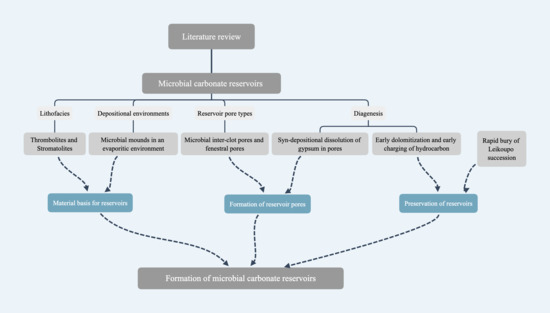Sedimentary and Diagenetic Features and Their Impacts on Microbial Carbonate Reservoirs in the Fourth Member of the Middle Triassic Leikoupo Formation, Western Sichuan Basin, China
Abstract
1. Introduction
2. Geological Setting
3. Samples and Analytical Method
4. Results
4.1. Lithofacies Types
4.1.1. Thrombolites
4.1.2. Stromatolites
4.1.3. Bioclastic Packstone
4.1.4. Grainstone
4.1.5. Anhydrite and Dolomitic Anhydrite
4.1.6. Crystalline Carbonates
4.2. Characteristics of Microbial Carbonate Reservoirs
4.2.1. Pore Types
4.2.2. Physical Properties
4.3. Geochemical Characteristics
4.3.1. Redox-Sensitive Trace Elements
4.3.2. Rare Earth Elements
4.3.3. Stable Carbon and Oxygen Isotopes
4.4. Diagenesis
4.4.1. Compaction
4.4.2. Dissolution
4.4.3. Cementation
4.4.4. Dolomitization
5. Discussion
5.1. Interpretation of Geochemical Characteristics
5.2. Depositional Environments
5.2.1. Lagoon
5.2.2. Microbial Mound
5.2.3. Shoal
5.3. Diagenetic Sequence and Pore Evolution
5.3.1. Eogenetic (Near-Surface) Period
5.3.2. Mesogenetic (Burial) Period
5.4. Impact of Sedimentation and Diagenesis on the Reservoirs of Lei-4
5.5. Preservation of Pores in Microbial Carbonate Reservoirs
6. Conclusions
Author Contributions
Funding
Conflicts of Interest
References
- Burne, R.V.; Moore, L.S. Microbialites: Organosedimentary deposits of benthic microbial communities. Palaios 1987, 2, 241–254. [Google Scholar] [CrossRef]
- Riding, R. Classification of microbial carbonates. In Calcareous Algae and Stromatolites; Springer: Berlin, Germany, 1991; pp. 21–51. [Google Scholar]
- Riding, R. Microbial carbonates: The geological record of calcified bacterial-algal mats and biofilms. Sedimentology 2000, 47 (Suppl. 1), 179–214. [Google Scholar] [CrossRef]
- Tewari, V.C.; Seckbach, J. Stromatolites: Interaction of Microbes with Sediments, Cellular Origin, Life In Extreme Habitats and Strobiology; Springer: Dordrecht, The Netherlands, 2011. [Google Scholar]
- Falicia, G. Living stromatolites of Shark Bay, Western Australia: Microbial inhabitants. In STROMATOLITES: Interaction of Microbes with Sediments, Cellular Origin, Life in Extreme Habitats and Astrobiology; Tewari, V.C., Seckbach, J., Eds.; Springer: Dordrecht, The Netherlands, 2011; Volume 18, pp. 343–358. [Google Scholar]
- Jamie, S.F.; Stefan, J.G. Microbial diversity in modern stromatolites. In STROMATOLITES: Interaction of Microbes with Sediments, Cellular Origin, Life in Extreme Habitats and Astrobiology; Tewari, V.C., Seckbach, J., Eds.; Springer: Dordrecht, The Netherlands, 2011; Volume 18, pp. 383–405. [Google Scholar]
- Reid, R.P.; Browne, K.M. Interidal stromatolites in a fringing Holocene reef complex, Bahamas. Geology 1991, 19, 15–18. [Google Scholar] [CrossRef]
- Ginsburg, R.N.; Planavsky, N.J. Diversity of Bahamian microbialite substrates. In Links between Geological Processed, Microbial Activities and Evolution of Life; Dilek, Y., Furnes, H., Muehlenbachs, K., Eds.; Springer: Dordrecht, The Netherlands, 2008; pp. 177–195. [Google Scholar]
- Kathleen, M.B. Modern marine stromatolitic structures: The sediment dilemma. In STROMATOLITES: Interaction of Microbes with Sediments, Cellular Origin, Life in Extreme Habitats and Astrobiology; Tewari, V.C., Seckbach, J., Eds.; Springer: Dordrecht, The Netherlands, 2011; Volume 18, pp. 291–312. [Google Scholar]
- Maria, E.F.; Daniel, G.P.; Maria, J.A.; Virginia, H.A. Modern stromatolite ecosystems at alkaline and hypersaline high-altitude lakes in the Argentinean Puna. In STROMATOLITES: Interaction of Microbes with Sediments, Cellular Origin, Life in Extreme Habitats and Astrobiology; Tewari, V.C., Seckbach, J., Eds.; Springer: Dordrecht, The Netherlands, 2011; Volume 18, pp. 427–441. [Google Scholar]
- Santos, F.; Peña, A.; Nogales, B.; Soria, E.; Garcia del Cura, M.A.; González-Martin, J.A.; Antón, J. Bacterial diversity in modern freshwater stromatolites from Ruidera Pools Natural Park, Spain. Syst. Appl. Microbiol. 2010, 33, 209–221. [Google Scholar] [CrossRef] [PubMed]
- Luo, P.; Wang, S.; Li, P.W.; Song, J.M.; Jin, T.F.; Wang, G.Q.; Yang, S.S. Review and prospectives of microbial carbonate reservoirs. Acta Sedimentol. Sin. 2013, 31, 807–823. [Google Scholar]
- Bosence, D.W.J.; Gibbons, K.A.; Heron, D.P.L.; Morgan, W.A. Microbial Carbonates in Space and Time: Implications for Global Exploration and Production; Geological Society London Special Publications: London, UK, 2015. [Google Scholar]
- Sheehan, P.M.; Harris, M.T. Microbialite resurgence after the Late Ordovician extinction. Nature 2004, 430, 75–78. [Google Scholar] [CrossRef] [PubMed]
- Słowakiewicz, M.; Tucker, M.E.; Pancost, R.D.; Perri, E.; Mawson, M. Upper Permian (Zechstein) microbialites: Supratidal through deep subtidal deposition, source rock, and reservoir potential. AAPG Bull. 2013, 97, 1921–1936. [Google Scholar] [CrossRef]
- Jiang, L.; Worden, R.H.; Cai, C.F.; Shen, A.J.; Crowley, S.F. Diagenesis of an evaporite-related carbonate reservoir in deeply buried Cambrian strata, Tarim Basin, Northwest China. AAPG Bull. 2018, 102, 77–102. [Google Scholar] [CrossRef]
- Baud, A.; Cirilli, S.; Marcoux, J. Biotic response to mass extinction: The lower most Triassic microbialites. Facies 1997, 36, 238–242. [Google Scholar]
- Heydari, E.; Hassanzadeh, J.; Wade, W.J.; Ghazi, A.M. Permian-Triassic boundary interval in the Abadeh section of Iran with implications for mass extinction: Part 1. Sedimentology. Palaeogeogr. Palaeoclimatol. Palaeoecol. 2003, 193, 405–423. [Google Scholar] [CrossRef]
- Hips, K.; Haas, J. Calcimicrobial stromatolites at the Permian-Triassic boundary in a western Tethyan section, Bǜkk Mountains, Hungary. Sediment. Geol. 2006, 185, 239–253. [Google Scholar] [CrossRef]
- Wignall, P.B.; Twitchett, R.J. Unusual intraclastic limestones in Lower Triassic carbonates and their bearing on the aftermath of the end-Permian mass extinction. Sedimentology 1999, 46, 303–316. [Google Scholar] [CrossRef]
- Marcoux, J.; Baud, A. The Permo-Triassic boundary in the Antalya nappes (western Taurides, Turkey). Mem. Soc. Geol. Ital. 1986, 34, 243–252. [Google Scholar]
- Liu, S.G.; Song, J.M.; Luo, P.; Qing, H.R.; Lin, T.; Sun, W.; Li, Z.W.; Wang, H.; Peng, H.L.; Yu, Y.Q.; et al. Characteristics of microbial carbonate reservoir and its hydrocarbon exploring outlook in the Sichuan Basin, China. J. Chengdu Univ. Technol. 2016, 43, 129–152. [Google Scholar]
- Zhai, X.F.; Wang, Z.C.; Luo, P.; Wang, T.S.; Shi, S.Y.; Zhang, H. Characteristics and origin of microbial dolomite reservoirs in Upper Sinian Deingying Formation, eastern Gaoshiti area, Sichuan Basin, SW China. Nat. Gas Geosci. 2017, 28, 1199–1210. [Google Scholar]
- Hu, W.X.; Zhu, J.Q.; Wang, X.L.; You, X.L.; He, K. Characteristics, origin and geological implications of the Cambrian microbial dolomite in Keping area, Tarim Basin. Oil Gas Geol. 2014, 35, 860–869. [Google Scholar]
- Li, P.W.; Luo, P.; Song, J.M.; Jin, T.F.; Wang, G.Q. Characteristics and main controlling factors of microbial carbonate reservoirs: A case study of Upper Sinian-Lower Cambrian in the northwestern margin of Tarim Basin. Acta Pet. Sin. 2015, 36, 1074–1089. [Google Scholar]
- Andersen, D.T.; Sumner, D.Y.; Hawes, I.; Webster-Brown, J.; Mckay, C.P. Discovery of large conical stromatolites in Lake Untersee, Antarctica. Geobiology 2011, 9, 280–293. [Google Scholar] [CrossRef]
- Reid, R.P.; Foster, J.S.; Radtke, G.; Golubic, S. Modern Marine Stromatolites of Little Darby Island, Exuma Archipelago, Bahamas: Environmental setting, Accretion Mechanisms and Role of Euendoliths. In Advances in Stromatolite Geobiology (Lecture Notes in Earth Sciences 131); Reitner, J., Quéric, N.V., Arp, G., Eds.; Springer: Berlin, Germany, 2011; pp. 77–89. [Google Scholar]
- Allen, M.A.; Goh, F.; Burns, B.P.; Neilan, B.A. Bacterial, archaeal and eukaryotic diversity of smooth and pustular microbial mat communities in the hypersaline lagoon of Shark Bay. Geobiology 2009, 7, 82–96. [Google Scholar] [CrossRef]
- Yu, J.R.; Fan, Z.R. Renqiu buried hill carbonate reservoir research. Acta Pet. Sin. 1981, 2, 57–70. [Google Scholar]
- Mancini, E.A.; Llins, J.C.; Parcell, W.C.; Aurell, M.; Bdenas, B.; Leinfelder, R.R.; Benson, D.J. Upper Jurassic thrombolite reservoir play, northeastern Gulf of Mexico. AAPG Bull. 2004, 88, 1573–1602. [Google Scholar] [CrossRef]
- Grotzinger, J.P.; Amthor, J.E. Facies and Reservoir Architecture of Isolated Microbial Carbonate Platforms, Terminal Proterozoic-Early Cambrian Ara Group, South Oman Salt Basin. AAPG Annu. Meet. 2002, A67, 10–13. [Google Scholar]
- Wright, P.V.; Racey, A. Pre-salt microbial carbonate reservoirs of the Santos basin, offshore Brazil. In AAPG Annual Convention and Exhibition; Al-Ameri, T., Ed.; AAPG: Denver, America, 2009; pp. 7–10. [Google Scholar]
- Al Haddad, S.; Mancini, E.A. Reservoir characterization, modeling, and evaluation of Upper Jurassic Smackover microbial carbonate and associated facies in Little Cedar Creek field, southwest Alabama, eastern Gulf coastal plain of the United States. AAPG Bull. 2013, 97, 2059–2083. [Google Scholar] [CrossRef]
- He, D.F.; Ma, Y.S.; Li, Y.Q.; Wu, S.L. New directions in an established gas play: Promising dolomite reservoirs in the Middle Triassic Leikoupo Formation of the Sichuan Basin, China. AAPG Bull. 2019, 103, 1–29. [Google Scholar] [CrossRef]
- Song, X.B.; Wang, Q.X.; Long, K.; Xu, G.M.; Shi, G.S.; Feng, X.; Deng, Q.; Cai, Z.H. Characteristics and main controlling factors of middle Triassic Leikoupo paleokarst reservoirs in Western Sichuan Basin. Mar. Orig. Pet. Geol. 2013, 18, 8–14. [Google Scholar]
- Xu, G.M.; Song, X.B.; Feng, X.; Long, K.; Wang, Q.X.; Shi, G.S.; Zhu, L. Gas potential of the Middle Triassic Leikoupo Fm in the Western Sichuan Basin. Nat. Gas Ind. 2013, 33, 8–14. [Google Scholar]
- Wu, S.X.; Li, H.T.; Long, S.X.; Liu, Z.L.; Wang, C.L.; Zhang, J.T. A study on characteristics and diagenesis of carbonate reservoirs in the Middle Triassic Leikoupo Formation in western Sichuan Depression. Oil Gas Geol. 2011, 32, 542–559. [Google Scholar]
- Li, R.; Long, K.; Song, X.B.; Xu, G.M.; Wang, Q.X.; Wang, D. Characteristics of high frequency sequence and control factors of development of the third bed of the member 4 of Leikoupo Formation in Western Sichuan Basin, China. J. Chengdu Univ. Technol. 2016, 43, 582–590. [Google Scholar] [CrossRef]
- Wang, H. The Characteristics and Main Controlling Factors of the Fourth Member of Middle Triassic Leikoupo Formation Microbialite Reservoir in the Western Sichuan Basin. Master’s Thesis, Chengdu University of Technology, Chengdu, China, 2018; pp. 1–146. [Google Scholar]
- Li, H.T.; Hu, X.Y.; Shi, Y.Q.; Xiao, K.H.; Jia, Y.W.; Wei, X.P.; Feng, Q. Sequence division and controlling factors of reservoir development of the 4th Member of Leikoupo Formation in foreland of Longmen Mountains in the Western Sichuan Depression, Sichuan Basin. Oil Gas Geol. 2017, 38, 753–763. [Google Scholar]
- Wang, Q.X.; Song, X.B.; Wang, D.; Long, K. Reservoir characteristics and formation mechanism of the 4th member of the Leikoupo Formation in Longmen Mountain front. Pet. Geol. Exp. 2017, 39, 491–497. [Google Scholar]
- He, D.F.; Li, D.S.; Zhang, G.W.; Zhao, L.Z.; Fan, C.; Lu, R.Q.; Wen, Z. Formation and evolution of multi-cycle superposed Sichuan Basin, China. Chin. J. Geol. 2011, 46, 589–606. [Google Scholar]
- Li, J.H.; Wang, H.H.; Li, W.B.; Zhou, X.B. Discussion on global tectonics evolution from plate reconstruction in Phanerozoic. Acta Pet. Sin. 2014, 35, 207–218. [Google Scholar]
- Liu, H.F.; Liang, H.S.; Cai, L.G.; Shen, F. Structural styles of the Longmenshan thrust belt and evolution of the foreland basin in western Sichuan Provence, China. Acta Geol. Sin. 1994, 7, 351–372. [Google Scholar]
- Liu, S.G.; Sun, W.; Zhong, Y.; Deng, B.; Song, J.M.; Ran, B.; Luo, Z.L.; Han, K.Y. Evolutionary episodes and their characteristics within the Sichuan marine craton basin during Phanerozoic Eon, China. Acta Petrol. Sin. 2017, 33, 1058–1072. [Google Scholar]
- Wu, Y.L.; Yan, Y.J.; Qin, J.H. Palaeogeographic reconstruction of the western margin of the Yangtze platform during the Early and Middle Triassic. Sediment. Geol. Tethyan Geol. 1995, 15, 17–33. [Google Scholar]
- Meng, Q.R.; Zhang, G.W. Timing of collision of the north and south China blocks: Controversy and reconciliation. Geology 1999, 27, 123–126. [Google Scholar] [CrossRef]
- Li, S.B.; Xu, G.M.; Song, X.B. Forming conditions of Pengzhou large gas field of Leikoupo Formation in Longmenshan piedmont tectonic belt, Western Sichuan Basin. China Petroleum Exploration. 2016, 21, 74–82. [Google Scholar]
- Tang, Y. Characterization of the sedimentation of the Leikoupo Formation and the weathering crust reservoirs at the top of the formation in the Western Sichuan Basin. Oil Gas Geol. 2013, 34, 42–47. [Google Scholar]
- Li, L.; Tan, X.C.; Cao, J.; Zou, C.; Ding, X.; Yang, G.; Ying, D.L. Origins of evaporites in the Middle Triassic Leikoupo Formation of the Sichuan Basin, southwest China and their geological implications. Carbonates Evaporites 2014, 29, 55–63. [Google Scholar] [CrossRef]
- Wang, W.K.; Xu, G.M.; Song, X.B.; Long, K.; Chen, Y. Genesis of gypsum-salt in the Leikoupo Formation and its hydrocarbon significance in the Sichuan Basin, China. J. Chengdu Univ. Technol. 2017, 44, 697–707. [Google Scholar]
- Liang, S.Y.; Chen, Y.B.; Zhao, G.W.; Wang, Y.Q.; Hu, Y. Geochemical characteristics of rare earth elements and their geological significance in the fourth member of the Middle Triassic Leikoupo Formation in Western Sichuan Basin. Pet. Geol. Exp. 2017, 39, 94–98. [Google Scholar]
- Chen, J.Y.; Han, Z.Z.; Fan, H.H.; Chi, N.J. Characteristics and Formation Mechanism of Cambrian Thrombolite in Western Shandong Province. Acta Geol. Sin. 2014, 88, 967–979. [Google Scholar]
- Moore, C.H. Carbonate Reservoirs-Porosity Evolution and Diagenesis in a Sequence Stratigraphy Framework. Elsevier Science; Elsevier: Amsterdam, The Netherlands, 2001. [Google Scholar]
- Brand, U.; Veizer, J. Chemical diagenesis of multicomponent carbonate system-2: Trace elements. J. Sediment Petrol. 1980, 50, 1219–1236. [Google Scholar]
- Huang, S.J. Cathodoluminescence and diagenetic alteration of marine carbonate minerals. Sediment. Facies Palaeogeogr. 1990, 10, 9–15. [Google Scholar]
- Kaufman, A.J.; Knoll, A.H. Neoproterozoic variations in the C-isotopic composition of seawater: Stratigraphic and biogeochemical implications. Precambrian Res. 1995, 73, 27–49. [Google Scholar] [CrossRef]
- Kaufman, A.J.; Jacobsen, S.B.; Knoll, A.H. The Vendian record of Sr and C isotopic variations in seawater: Implications for tectonics and paleoclimate. Earth Planet. Sci. Lett. 1993, 120, 409–430. [Google Scholar] [CrossRef]
- Jiang, Q.C.; Ma, Y.S.; Shen, Y.C.; Guo, R.T.; Gao, X.Q.; Liu, B.; Cui, J.; Wu, K.Y. High-frequency redox variations of the Eocene cyclic lacustrine sediments in the Yingxi area, western Qaidam Basin, China. J. Asian Earth Sci. 2019, 174, 135–151. [Google Scholar] [CrossRef]
- Hatch, J.R.; Leventhal, J.S. Relationship between inferred redox potential of the depositional environment and geochemistry of the Upper Pennsylvanian (Missourian) stark shale member of the Dennis Limestone, Wabaunsee County, Kansas, USA. Chem. Geol. 1992, 99, 65–82. [Google Scholar] [CrossRef]
- Jones, B.; Manning, D.A.C. Comparison of geochemical indices used for the interpretation of palaeoredox conditions in ancient mudstones. Chem. Geol. 1994, 111, 111–129. [Google Scholar] [CrossRef]
- Rimmer, S.M. Geochemical paleoredox indicators in Devonian-Mississippian black shales, Central Appalachian Basin (USA). Chem. Geol. 2004, 206, 373–391. [Google Scholar] [CrossRef]
- Bjørlykke, K.; Jahren, J. Open closed geochemical systems during diagenesis in sedimentary basins: Constraints on mass transfer during diagenesis and the prediction of porosity in sandstone and carbonate reservoirs. AAPG Bull. 2012, 96, 2193–2214. [Google Scholar] [CrossRef]
- Zhang, S.M.; Liu, B.; Qin, S.; Tian, Y.J.; Zhang, X.F.; Guo, R.T. Deeply buried diagenetic process and its significance for the carbonate of Changxing Formation in the northeastern Sichuan Basin. Acta Petrol. Sin. 2017, 33, 1295–1304. [Google Scholar]
- Ehrenberg, S.N.; Walderhaug, O.; Bjørlykke, K. Carbonate porosity creation by mesogenetic dissolution: Reality or Illusion? AAPG Bull. 2012, 97, 345. [Google Scholar] [CrossRef]
- Hao, F.; Zhang, X.F.; Wang, C.W.; Li, P.P.; Guo, T.L.; Zou, H.Y.; Zhu, Y.M.; Liu, J.Z.; Cai, Z.X. The fate of CO2, derived from thermochemical sulfate reduction (TSR) and effect of TSR on carbonate porosity and permeability, Sichuan Basin, China. Earth-Sci. Rev. 2015, 141, 154–177. [Google Scholar] [CrossRef]
- Jiang, L.; Cai, C.F.; Worden, R.H.; Crowley, S.F.; Jia, L.Q.; Zhang, K.; Duncan, L. Multiphase dolomitization of deeply buried Cambrian petroleum reservoirs, Tarim Basin, north-west China. Sedimentology 2016, 63, 2130–2157. [Google Scholar] [CrossRef]
- Bau, M.; Möller, P.; Dulski, P. Yttrium and lanthanides in eastern Mediterranean seawater and their fractionation during redox-cycling. Mar. Chem. 1997, 56, 123–131. [Google Scholar] [CrossRef]
- Zhao, Y.Y.; Li, S.Z.; Li, D.; Guo, L.L.; Dai, L.M.; Tao, J.L. Rare Earth Element Geochemistry of Carbonate and its Paleoenvironmental Implications. Geotecton. Metallog. 2019, 43, 141–167. [Google Scholar]
- Paquette, J.; Reeder, R.J. Relationship between surface structure, growth mechanism, and trace element in corporation in calcite. Geochim. Cosmochim. Acta 1995, 59, 735–749. [Google Scholar] [CrossRef]
- Liu, Q.Q.; Chi, Q.H.; Wang, X.Q.; Zhou, J.; Liu, H.L.; Liu, D.S.; Gao, Y.F.; Zhai, D.X. Distribution and influencing factors of rare earth elements in carbonate rocks along three continental-scale transects in eastern China. Earth Sci. Front. 2018, 25, 99–115. [Google Scholar]
- Hu, Z.G.; Zheng, R.C.; Hu, J.Z.; Wen, H.G.; Li, Y.; Wen, Q.B.; Xu, F.B. Geochemical characteristics of rare earth elements of Huanglong Formation dolomites reservoirs in Eastern Sichuan—Northern Chongqing area. Acta Geol. Sin. 2009, 83, 782–790. [Google Scholar]
- Bau, M. Rare earth element mobility during hydrothermal and metamorphic fluid-rock interaction and the significance of the oxidation state of europium. Chem. Geol. 1991, 93, 219–230. [Google Scholar] [CrossRef]
- Bau, M.; Koschinsky, A. Oxidative scavenging of cerium on hydrous Fe oxide: Evidence from the distribution of rare earth elements and yttrium between Fe oxides and Mn oxides in hydrogenetic ferromanganese crusts. Geochem. J. 2009, 43, 37–47. [Google Scholar] [CrossRef]
- Banerjee, A.; Słowakiewicz, M.; Majumder, T.; Sayani, K.; Sarbani, P.; Maurice, E.T.; Dilip, S. A Palaeoproterozoic dolomite (Vempalle Formation, Cuddapah Basin, India) showing Phanerozoic-type dolomitisation. Precambrian Res. 2019, 328, 9–26. [Google Scholar] [CrossRef]
- Kamber, B.S.; Webb, G.E. The geochemistry of late Archaean microbial carbonate: Implications for ocean chemistry and continental erosion history. Geochim. Cosmochim. Acta 2001, 65, 2509–2525. [Google Scholar] [CrossRef]
- Van Kranendonk, M.J.; Webb, G.E.; Kamber, B.S. Geological and trace element evidence for a marine sedimentary environment of deposition and biogenicity of 3.45 Ga stromatolitic carbonates in the Pilbara Craton, and support for a reducing Archaean ocean. Geobiology 2003, 1, 91–108. [Google Scholar] [CrossRef]
- Franchi, F.; Hofmann, A.; Cavalazzi, B.; Wilson, A.; Barbieri, R. Differentiating marine vs hydrothermal processes in Devonian carbonate mounds using rare earth elements (Kess mounds, Anti-Atlas, Morocco). Chem. Geol. 2015, 409, 69–86. [Google Scholar] [CrossRef]
- Korte, C.; Kozur, H.W.; Veizer, J. δ13C and δ18O values of Triassic brachiopods and carbonate rocks as proxies for coeval seawater and palaeotemperature. Palaeogeogr. Palaeoclimatol. Palaeoecol. 2005, 226, 287–306. [Google Scholar] [CrossRef]
- Huang, S.J.; Huang, K.K.; Lü, J.; Lan, Y.F. Carbon isotopic composition of Early Triassic marine carbonates, Eastern Sichuan Basin, China. Sci. China Earth Sci. 2012, 55, 2026–2038. [Google Scholar] [CrossRef]
- Sumner, D.Y. Microbial Influences on Local Carbon Isotopic Ratios and Their Preservation in Carbonate. Astrobiology 2001, 1, 57–70. [Google Scholar] [CrossRef]
- Kolber, Z.S.; Plumley, F.G.; Lang, A.S.; Beatty, J.T.; Blankenship, R.E.; VanDover, C.L.; Vetriani, C.; Koblizek, M.; Rathgeber, C.; Falkowski, P.G. Contribution of aerobic photoheterotrophic bacteria to the carbon cycle in the ocean. Science 2001, 292, 2492–2495. [Google Scholar] [CrossRef] [PubMed]
- Chen, R.K. Application of Stable Oxygen and Carbon Isotope in the Research of Carbonate Diagenetic Environment. Acta Sedimentol. Sin. 1994, 12, 11–21. [Google Scholar]
- Qiu, N.S.; Qin, J.Z.; McInnes, B.; Wang, J.; Teng, G.E.; Zheng, L.J. Tectonothermal evolution of the northeastern Sichuan Basin: Constraints from apatite and zircon (U-Th)/He ages and vitrinite reflectance data. Geol. J. China Univ. 2008, 14, 223–230. [Google Scholar]
- Zhao, X.; Qing, L.; Jiang, Z.; Zhang, R. Organic geochemistry and reservoir characterization of the organic matter-rich calcilutite in the Shulu Sag, Bohai Bay Basin, North China. Mar. Pet. Geol. 2014, 51, 239–255. [Google Scholar] [CrossRef]
- Słowakiewicz, M.; Mikołajewski, Z. Sequence stratigraphy of the Upper Permian Zechstein Main Dolomite carbonates in western Poland: A new approach. J. Pet. Geol. 2009, 32, 215–234. [Google Scholar] [CrossRef]
- Chafetz, H.S. Porosity in bacterially induced carbonates: Focus on micropores. AAPG Bull. 2013, 97, 2103–2111. [Google Scholar] [CrossRef]
- Bosak, T.; Souza-egipsy, V.; Corsetti, F.A.; Newman, D.K. Micrometer-scale porosity as a biosignature in carbonate crusts. Geology 2004, 32, 781–784. [Google Scholar] [CrossRef]
- Słowakiewicz, M.; Perri, E.; Tucker, M.E. Micro- and nanopores in tight Zechstein 2 carbonate facies from the Southern Permian Basin, NW Europe. J. Pet. Geol. 2016, 39, 149–168. [Google Scholar] [CrossRef]

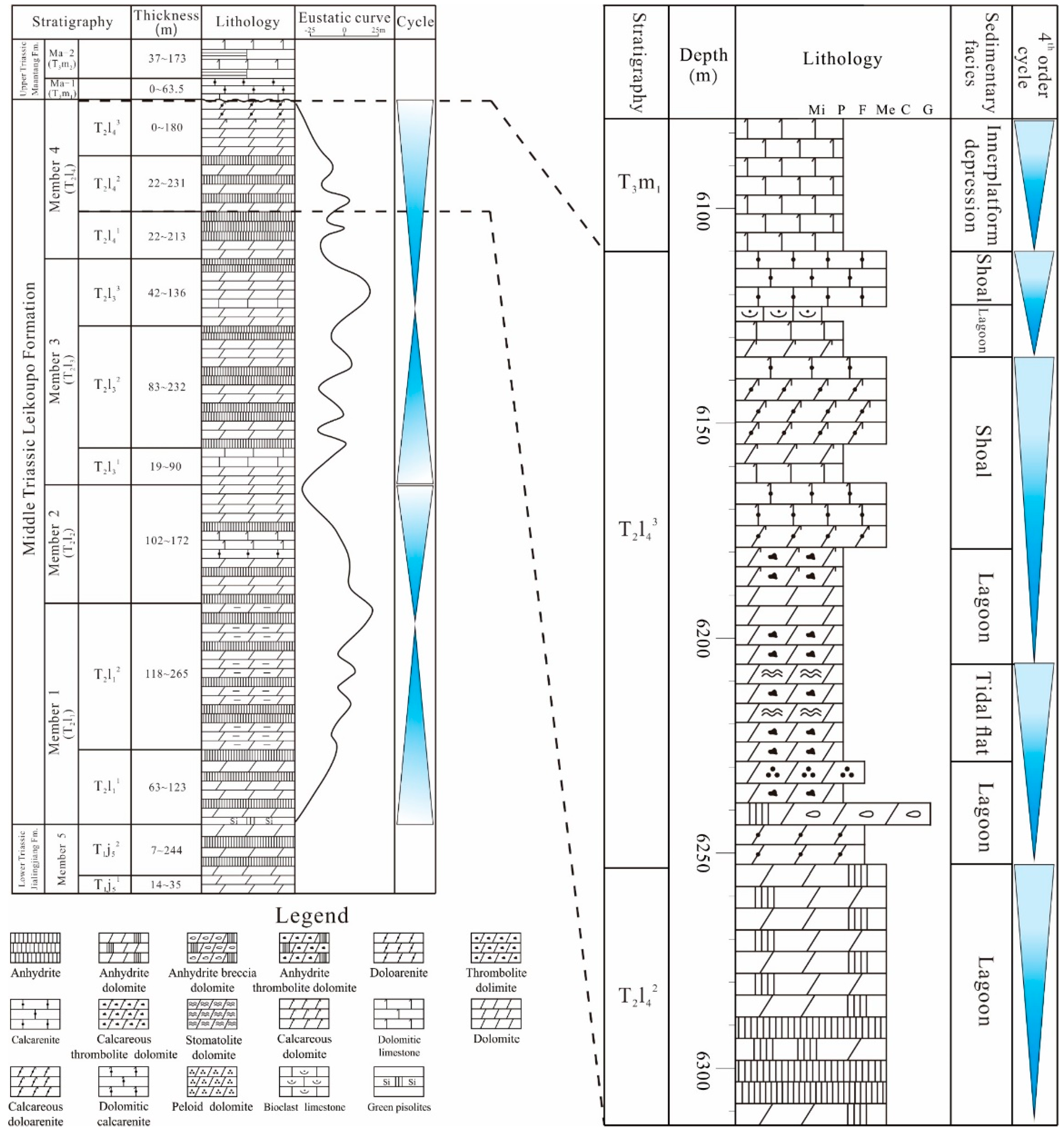
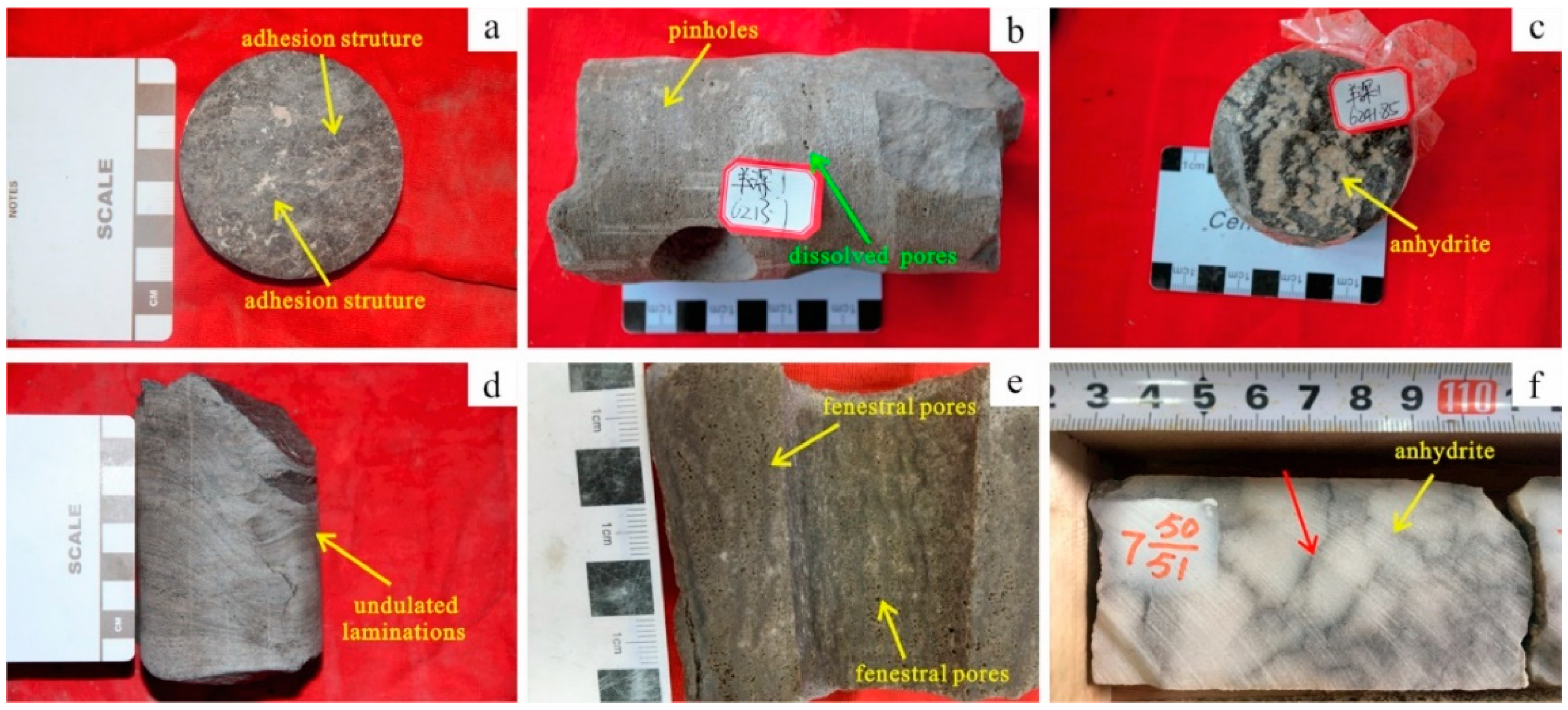
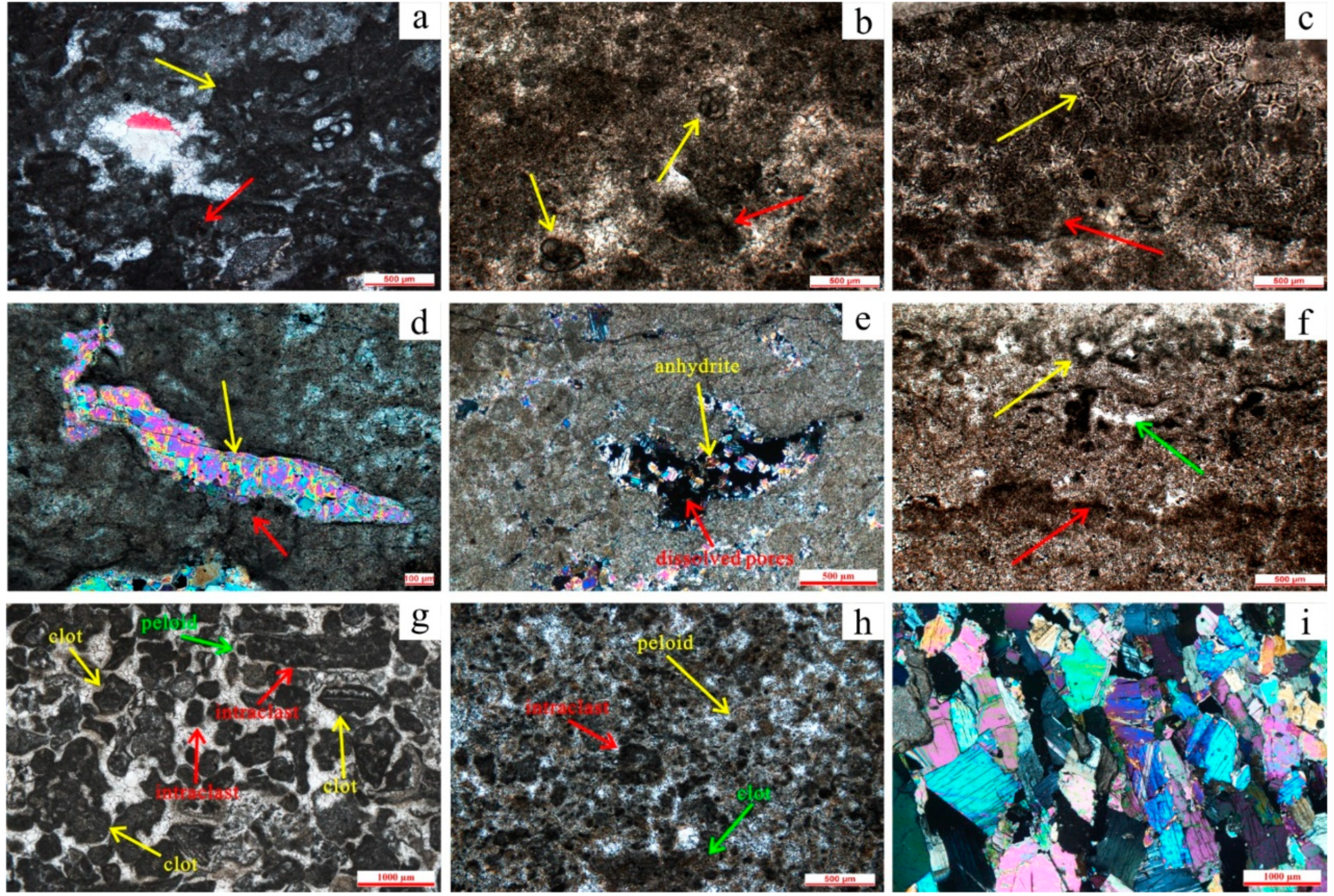


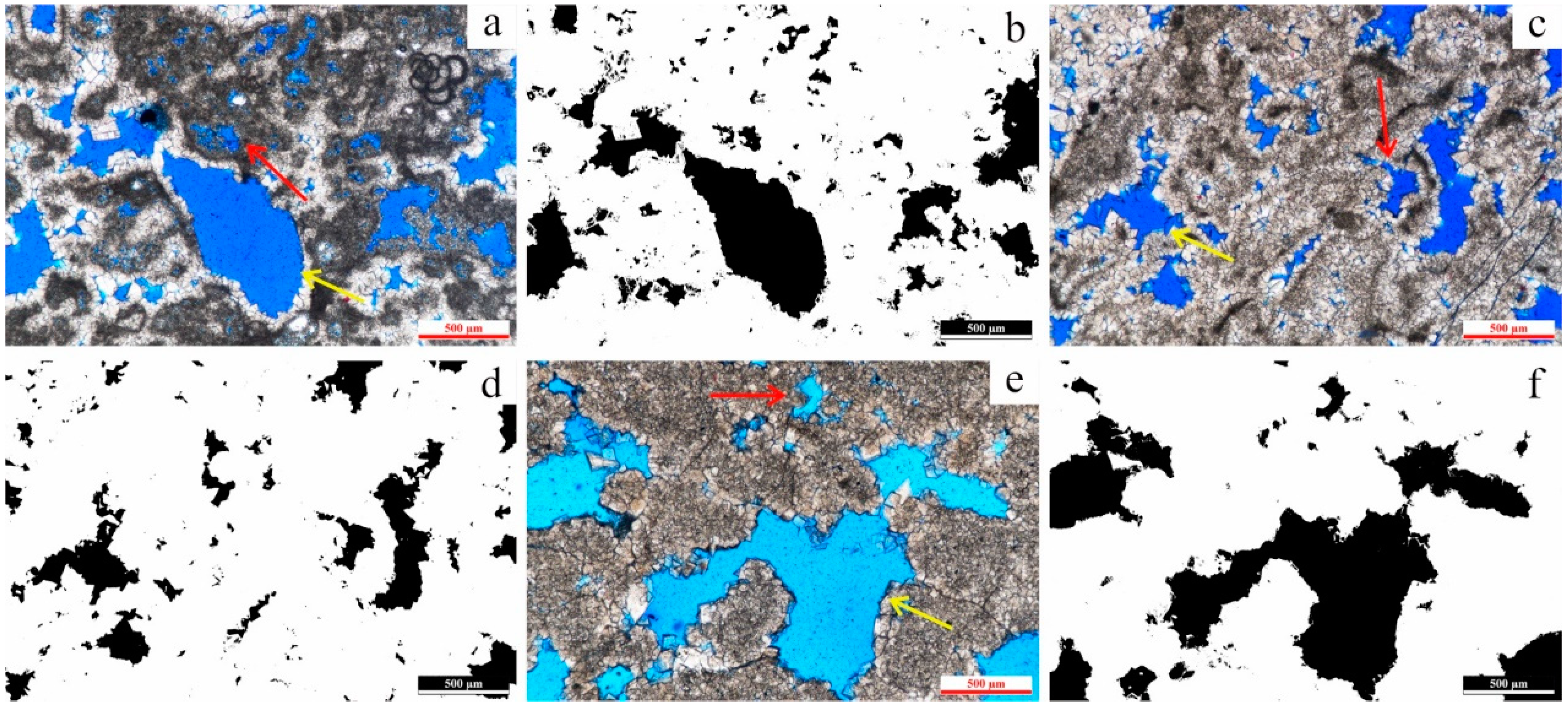
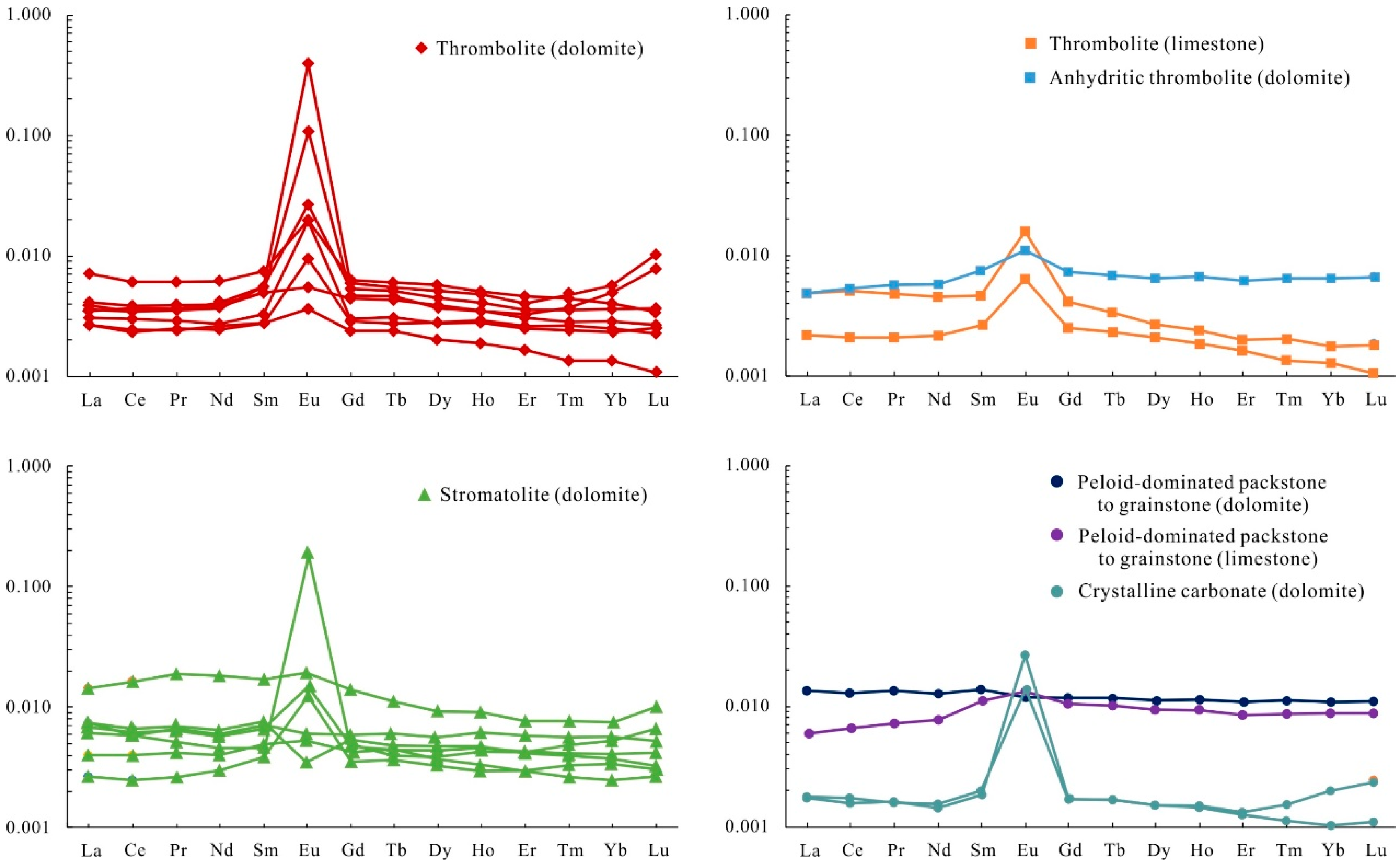

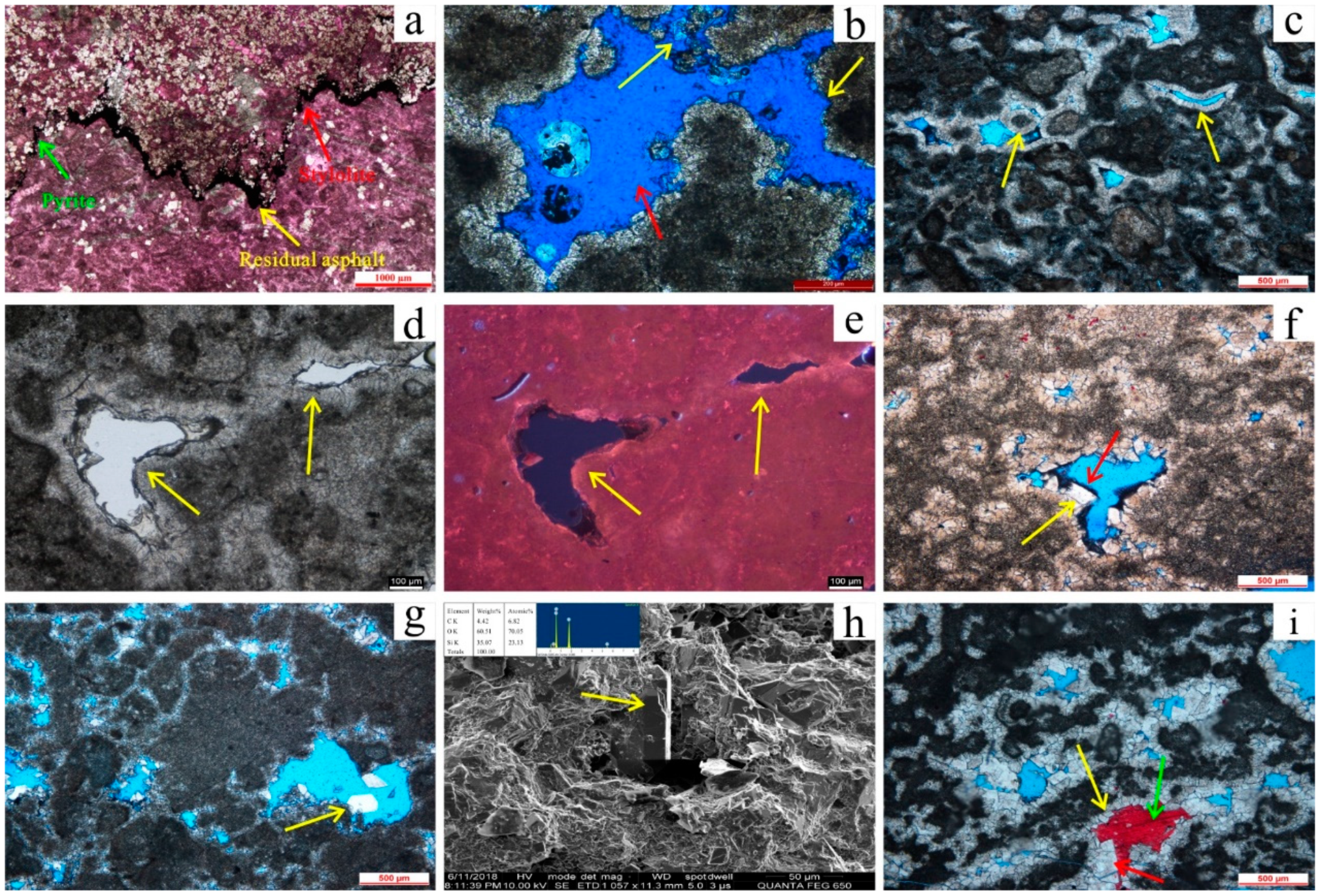
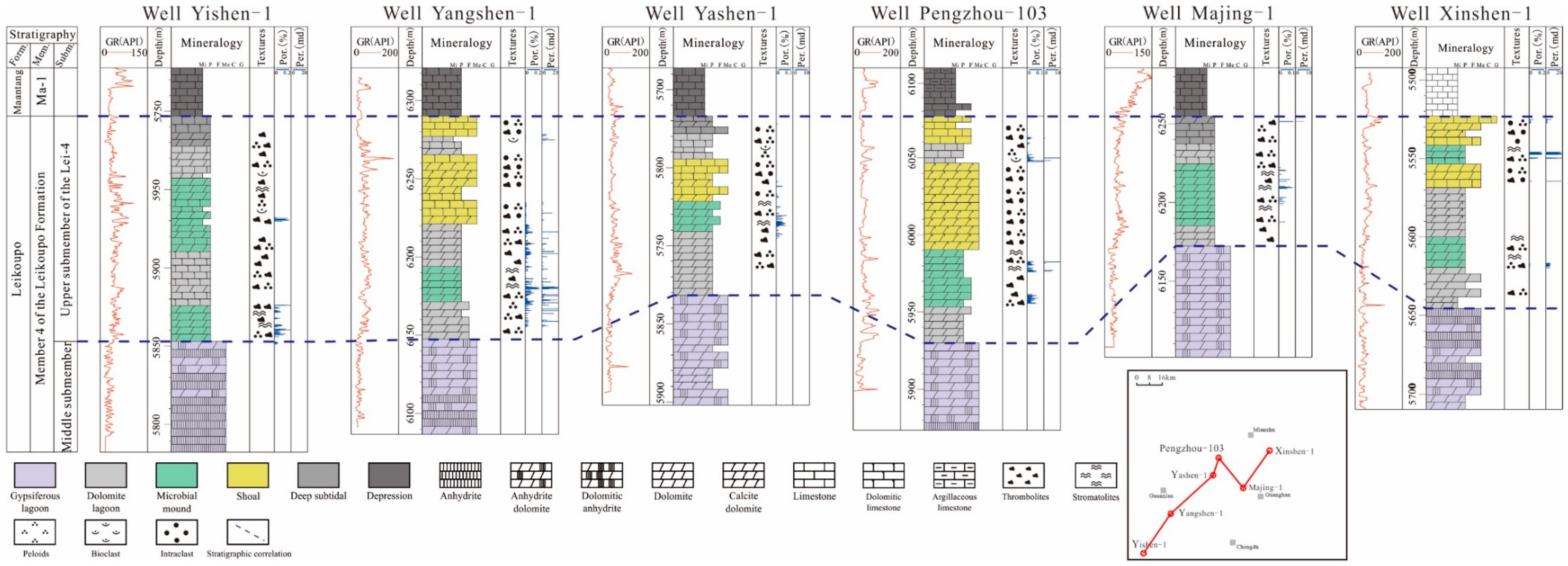
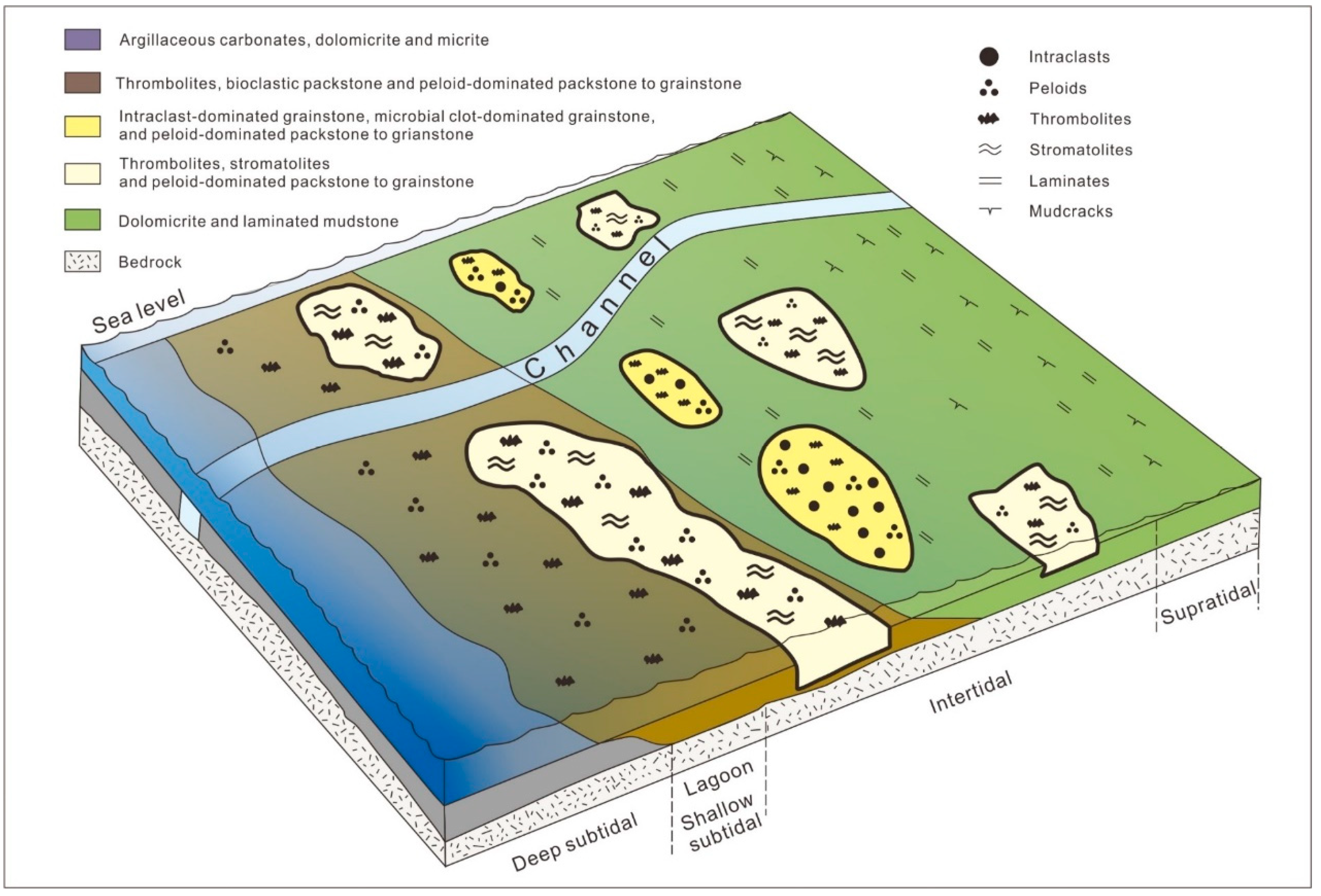

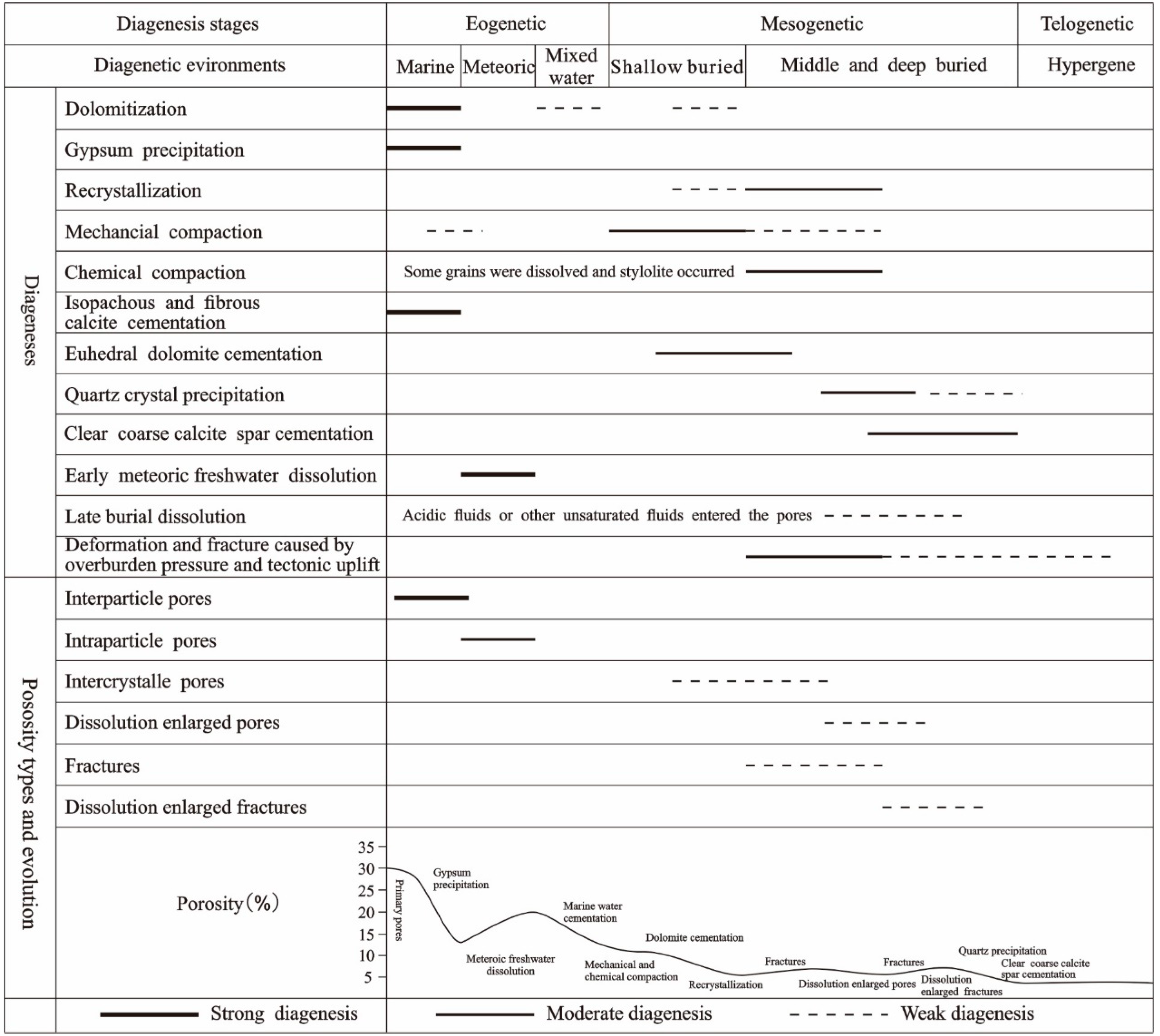
| Lithofacies | Sedimentary Texture | Types of Grains | Size of Grains/Crystal | Palaeontologic Association | Description | Water Energy | Depositional Environment | |
|---|---|---|---|---|---|---|---|---|
| A | Thrombolites | Microbial clotted fabric | Few peloids | Micrite (clot) Silt (peloid) | Miliolinid foraminifera Textulariid foraminifera (single chamber and biserial chamber) | Moderate dolomitization, micrite to silt crystal, irregular shaped clots and spheriform peloid | Low to medium | Shallow subtidal, intertidal |
| B | Anhydritic thrombolites | Microbial clotted fabric | Few peloids | Micrite (clot) Silt (peloid) | A few miliolinid foraminifera | Strong dolomitization, micrite to silt crystal, fully cemented by anhydrite | Low | Lagoon |
| C | Stromatolites | Microbial laminated structure | Few peloids | Micrite (lamination) Silt (peloid) | A few miliolinid foraminifera | Strong dolomitization, micrite to silt crystal, slightly undulated laminations | Medium to high | Microbial mounds |
| D | Bioclastic packstone | Grain-supported | Bioclasts | Silt (bioclasts) | Mainly miliolinid foraminifera and few shells | Weak dolomitization, micrite crystal | Low | Lagoon |
| E | Intraclast-dominated grainstone | Grain-supported | Intraclasts (primary) Isolated microbial clots Peloids | Silt-fine (intraclasts) Fine-coarse (microbial clots) Fine (peloids) | Few miliolinid foraminifera | Moderate dolomitization, silt to fine, fully cemented by calcite or dolomite | High | Shoal (intertidal) |
| F | Microbial clot-dominated grainstone | Grain-supported | Isolated microbial clots (primary) Intraclasts Peloids | Fine-coarse (microbial clots) Silt-fine (intraclasts) Silt (peloids) | Few miliolinid foraminifera | Moderate dolomitization, silt to coarse, fully cemented by calcite or dolomite | High | Shoal (intertidal) |
| G | Peloid-dominated packstone to grainstone | Grain-supported | Peloids (primary) Intraclasts | Silt (peloids) Silt-fine (intraclasts) | Few miliolinid foraminifera | Moderate dolomitization, silt to fine, fully cemented by calcite or dolomite | Medium | Lagoon, intertidal |
| H | Anhydrite | Crystalline texture | None | Medium-fine (anhydrite) | None | Medium to fine crystal, dense cementation | Low | Lagoon |
| I | Dolomitic anhydrite | Crystalline texture | None | Medium-fine (anhydrite) Micrite (microbial filaments) | None | Medium to fine crystal, dense cementation, filamentous microbial structure | Low | Lagoon |
| J | Crystalline carbonates | Crystalline texture | None | Micrite-fine (dolomite) Micrite (calcite) | None | Moderate dolomitization, micrite to silt, residual microbial texture | Low to medium | Lagoon, intertidal |
| Well | Depth(m) | Areal Porosity (%) | Total Area of Pores (×106 μm2) | Area of Inter-Clot Pores (×106 μm2) | Area Percentage of Inter-Clot Pores (%) | Area of Intra-Clot Pores (×106 μm2) | Area Percentage of Intra-Clot Pores (%) | Area of Inter-Crystal Pores (×106 μm2) | Area Percentage of Inter-Crystal Pores (%) |
|---|---|---|---|---|---|---|---|---|---|
| XS-1 | 5549.2 | 9.52 | 1.52 | 1.24 | 81.87 | 0.15 | 9.61 | 0.13 | 8.52 |
| XS-1 | 5551.2 | 7.75 | 1.24 | 1.08 | 86.91 | 0.00 | 0.00 | 0.16 | 13.09 |
| YaS-1 | 5781.7 | 3.84 | 0.49 | 0.43 | 89.08 | 0.00 | 0.00 | 0.05 | 10.93 |
| YaS-1 | 5782.6 | 9.73 | 1.56 | 1.46 | 93.75 | 0.00 | 0.00 | 0.10 | 6.25 |
| YaS-1 | 5782.9 | 7.22 | 1.16 | 1.03 | 88.78 | 0.03 | 2.45 | 0.10 | 8.77 |
| YS-1 | 6219.5 | 17.31 | 2.77 | 2.62 | 94.57 | 0.04 | 1.47 | 0.11 | 3.96 |
| YS-1 | 6222.3 | 13.26 | 2.15 | 1.80 | 83.97 | 0.20 | 9.32 | 0.14 | 6.71 |
| YS-1 | 6228.6 | 13.78 | 0.73 | 0.42 | 57.16 | 0.29 | 39.24 | 0.03 | 3.60 |
| YS-1 | 6191.4 | 10.33 | 1.65 | 1.47 | 88.83 | 0.00 | 0.00 | 0.18 | 11.17 |
| YS-1 | 6191.9 | 5.80 | 0.93 | 0.78 | 83.96 | 0.02 | 1.95 | 0.13 | 14.09 |
| Average | 9.85 | 1.42 | 1.23 | 84.89 | 0.07 | 6.40 | 0.11 | 8.71 | |
| Depth (m). | Well | Lithofacies | Th (ppm) | U (ppm) | V (ppm) | Ni (ppm) | Mn (ppm) | Sr (ppm) | Co (ppm) | Mn/Sr | Th/U | V/V + Ni | Ni/Co |
|---|---|---|---|---|---|---|---|---|---|---|---|---|---|
| 6228.60 | YS1 | Facies A | 0.02 | 4.69 | 9.09 | 1.49 | 19.88 | 134.79 | 0.14 | 0.15 | 0.01 | 0.86 | 10.39 |
| 6222.30 | YS1 | Facies A | 0.01 | 4.56 | 18.66 | 1.42 | 15.52 | 117.78 | 0.15 | 0.13 | 0.00 | 0.93 | 9.51 |
| 5779.00 | YaS1 | Facies A | 0.02 | 6.60 | 15.98 | 3.98 | 13.24 | 65.32 | 0.29 | 0.20 | 0.00 | 0.80 | 13.66 |
| 5782.90 | YaS1 | Facies A | 0.07 | 7.80 | 54.40 | 3.82 | 15.22 | 65.84 | 0.34 | 0.23 | 0.01 | 0.93 | 11.40 |
| 5551.20 | XS1 | Facies A | 0.05 | 3.76 | 12.42 | 4.08 | 9.43 | 98.65 | 0.32 | 0.10 | 0.01 | 0.75 | 12.75 |
| 5982.38 | LS1 | Facies A | 0.13 | 3.30 | 10.44 | 4.63 | 6.03 | 141.63 | 0.38 | 0.04 | 0.04 | 0.69 | 12.20 |
| 5785.90 | YaS1 | Facies A | 0.12 | 3.86 | 13.80 | 4.25 | 13.87 | 94.50 | 0.37 | 0.15 | 0.03 | 0.77 | 11.47 |
| 6045.57 | PZ103 | Facies A | 0.03 | 4.79 | 20.94 | 9.89 | 12.16 | 135.53 | 0.49 | 0.09 | 0.01 | 0.68 | 20.18 |
| 5976.53 | LS1 | Facies A | 0.11 | 5.87 | 11.96 | 5.31 | 5.16 | 95.97 | 0.44 | 0.05 | 0.02 | 0.69 | 12.14 |
| 5729.30 | YaS1 | Facies A | 0.15 | 2.91 | 22.32 | 4.68 | 2.95 | 64.19 | 0.58 | 0.05 | 0.05 | 0.83 | 8.02 |
| 5730.20 | YaS1 | Facies A | 0.01 | 2.36 | 14.30 | 8.16 | 2.12 | 260.60 | 0.63 | 0.01 | 0.01 | 0.64 | 12.95 |
| 5628.80 | XS1 | Facies B | 0.03 | 0.14 | 1.58 | 6.32 | 0.00 | 3220.69 | 0.45 | 0.00 | 0.17 | 0.20 | 14.05 |
| 5987.48 | LS1 | Facies A | 0.21 | 5.45 | 9.75 | 5.91 | 2.77 | 104.94 | 0.72 | 0.03 | 0.04 | 0.62 | 8.16 |
| 5970.82 | LS1 | Facies A | 0.01 | 11.10 | 21.47 | 5.64 | 5.06 | 99.14 | 0.42 | 0.05 | 0.00 | 0.79 | 13.48 |
| 5978.86 | LS1 | Facies A | 0.04 | 5.44 | 17.10 | 5.49 | 3.45 | 65.04 | 0.38 | 0.05 | 0.01 | 0.76 | 14.30 |
| 6207.10 | YS1 | Facies C | 0.07 | 7.19 | 41.11 | 5.53 | 16.10 | 114.79 | 0.55 | 0.14 | 0.01 | 0.88 | 10.10 |
| 5826.50 | PZ1 | Facies C | 0.39 | 3.93 | 20.21 | 4.63 | 11.87 | 94.59 | 0.47 | 0.13 | 0.10 | 0.81 | 9.81 |
| 6219.50 | YS1 | Facies C | 0.02 | 1.95 | 8.00 | 3.99 | 13.53 | 107.45 | 0.32 | 0.13 | 0.01 | 0.67 | 12.35 |
| 5986.08 | LS1 | Facies C | 0.06 | 5.85 | 12.02 | 5.49 | 4.95 | 94.01 | 0.45 | 0.05 | 0.01 | 0.69 | 12.09 |
| 5717.60 | XaS1 | Facies C | 0.03 | 3.90 | 33.85 | 5.14 | 14.87 | 189.17 | 0.46 | 0.080 | 0.01 | 0.87 | 11.30 |
| 5990.46 | LS1 | Facies C | 0.02 | 3.55 | 6.17 | 5.77 | 3.11 | 99.77 | 0.43 | 0.03 | 0.01 | 0.52 | 13.31 |
| 5979.54 | LS1 | Facies C | 0.08 | 8.55 | 48.15 | 8.45 | 4.594 | 107.51 | 0.58 | 0.04 | 0.01 | 0.85 | 14.60 |
| 6185.60 | YS1 | Facies G | 0.04 | 3.81 | 15.28 | 5.24 | 10.36 | 164.57 | 0.44 | 0.06 | 0.01 | 0.75 | 11.87 |
| 6234.90 | YS1 | Facies G | 0.00 | 2.68 | 10.13 | 4.03 | 7.88 | 127.69 | 0.30 | 0.06 | 0.00 | 0.72 | 13.38 |
| 5711.10 | XaS1 | Facies G | 0.09 | 6.86 | 40.76 | 5.35 | 100.93 | 124.56 | 0.49 | 0.81 | 0.01 | 0.88 | 10.93 |
| Sample | Well | Depth (m) | Lithofacies | Elemental Mass Fraction (×10−3 μg·g−1, PAAS) | ∑REE (μg·g−1, PAAS) | ∑LREE/∑HREE (PAAS) | δCe | δEu | |||||||||||||
|---|---|---|---|---|---|---|---|---|---|---|---|---|---|---|---|---|---|---|---|---|---|
| La | Ce | Pr | Nd | Sm | Eu | Gd | Tb | Dy | Ho | Er | Tm | Yb | Lu | ||||||||
| 6228.6 | YS1 | 6228.60 | Facies A | 7 | 6 | 6 | 6 | 7 | 19 | 6 | 6 | 6 | 5 | 5 | 4 | 4 | 3 | 0.091 | 1.298 | 0.943 | 2.851 |
| 6222.3 | YS1 | 6222.30 | Facies A | 4 | 4 | 4 | 4 | 5 | 27 | 5 | 5 | 5 | 4 | 4 | 4 | 4 | 4 | 0.081 | 1.403 | 0.932 | 5.091 |
| 5779 | Ya1 | 5779.00 | Facies A | 3 | 2 | 2 | 3 | 3 | 10 | 3 | 3 | 3 | 3 | 3 | 3 | 2 | 2 | 0.044 | 1.055 | 0.942 | 3.430 |
| 5782.9 | Ya1 | 5782.90 | Facies A | 4 | 4 | 4 | 4 | 5 | 101 | 5 | 5 | 4 | 4 | 3 | 4 | 5 | 8 | 0.158 | 3.317 | 0.931 | 21.093 |
| 5551.2 | XS1 | 5551.20 | Facies A | 4 | 3 | 4 | 4 | 5 | 352 | 6 | 6 | 5 | 5 | 4 | 5 | 6 | 10 | 0.418 | 8.074 | 0.914 | 63.876 |
| LS1-38 | LS1 | 5982.38 | Facies A | 3 | 2 | 2 | 2 | 3 | 4 | 2 | 2 | 2 | 2 | 2 | 1 | 1 | 1 | 0.031 | 1.165 | 0.920 | 1.428 |
| PZ103-2 | PZ103 | 6045.57 | Facies A | 3 | 3 | 3 | 3 | 3 | 19 | 3 | 3 | 3 | 3 | 3 | 2 | 2 | 3 | 0.056 | 1.595 | 1.030 | 6.168 |
| LS1-46 | LS1 | 5976.53 | Facies A | 4 | 4 | 4 | 4 | 5 | 6 | 4 | 4 | 4 | 4 | 3 | 3 | 3 | 3 | 0.054 | 0.959 | 0.936 | 1.217 |
| LS1-53 | LS1 | 5970.82 | Facies A | 5 | 5 | 5 | 5 | 5 | 16 | 4 | 3 | 3 | 2 | 2 | 2 | 2 | 2 | 0.059 | 1.954 | 1.084 | 3.909 |
| LS1-43 | LS1 | 5978.86 | Facies A | 2 | 2 | 2 | 2 | 3 | 6 | 2 | 2 | 2 | 2 | 2 | 1 | 1 | 1 | 0.031 | 1.244 | 0.938 | 2.508 |
| 6224.21 | YS1 | 6224.21 | Facies B | 5 | 5 | 6 | 6 | 8 | 11 | 7 | 7 | 7 | 7 | 6 | 7 | 6 | 7 | 0.093 | 0.759 | 0.981 | 1.495 |
| 6207.1 | YS1 | 6207.10 | Facies C | 6 | 6 | 7 | 6 | 7 | 6 | 6 | 6 | 6 | 6 | 6 | 6 | 6 | 5 | 0.084 | 0.838 | 0.932 | 0.895 |
| 5826.5 | PZ1 | 5826.50 | Facies C | 14 | 16 | 19 | 19 | 17 | 19 | 14 | 11 | 9 | 9 | 8 | 8 | 8 | 10 | 0.181 | 1.361 | 0.995 | 1.335 |
| 6219.5 | YS1 | 6219.50 | Facies C | 7 | 6 | 5 | 5 | 5 | 179 | 4 | 4 | 4 | 4 | 4 | 5 | 5 | 7 | 0.244 | 5.494 | 0.998 | 41.305 |
| LS1-31 | LS1 | 5986.08 | Facies C | 4 | 4 | 4 | 4 | 5 | 5 | 4 | 4 | 4 | 3 | 3 | 3 | 2 | 3 | 0.053 | 0.986 | 1.010 | 1.144 |
| 5717.6 | XaS1 | 5717.60 | Facies C | 3 | 2 | 3 | 3 | 4 | 13 | 4 | 4 | 3 | 3 | 3 | 3 | 3 | 3 | 0.054 | 1.039 | 0.877 | 3.347 |
| LS1-24 | LS1 | 5990.46 | Facies C | 7 | 6 | 7 | 6 | 7 | 3 | 5 | 5 | 5 | 5 | 4 | 4 | 4 | 3 | 0.072 | 1.092 | 0.961 | 0.559 |
| LS1-48 | LS1 | 5979.54 | Facies C | 7 | 6 | 7 | 6 | 7 | 15 | 5 | 4 | 4 | 5 | 4 | 4 | 4 | 4 | 0.082 | 1.351 | 0.986 | 2.740 |
| 6185.6 | YS1 | 6185.60 | Facies G | 13 | 13 | 13 | 13 | 14 | 12 | 12 | 12 | 11 | 12 | 11 | 11 | 11 | 11 | 0.168 | 0.866 | 0.971 | 0.952 |
| 5711.1 | XaS1 | 5711.10 | Facies G | 6 | 7 | 7 | 8 | 11 | 13 | 10 | 10 | 9 | 9 | 9 | 9 | 9 | 9 | 0.126 | 0.698 | 0.971 | 1.175 |
| 5725.2 | YaS1 | 5725.20 | Facies J | 2 | 2 | 2 | 1 | 2 | 26 | 2 | 2 | 2 | 1 | 1 | 2 | 2 | 2 | 0.048 | 2.559 | 1.010 | 14.666 |
| 5767.8 | YaS1 | 5767.80 | Facies J | 2 | 2 | 2 | 2 | 2 | 14 | 2 | 2 | 2 | 1 | 1 | 1 | 1 | 1 | 0.033 | 2.053 | 1.052 | 7.495 |
| Sample | Well | Depth(m) | Lithofacies | δ18O(VPDB) (‰) | δ13C(VPDB) (‰) | Porosity (%) |
|---|---|---|---|---|---|---|
| 6228.6 | YS1 | 6228.60 | Facies A (Dolomite) | −6.41 | 2.43 | 7.16 |
| 6222.3 | YS1 | 6222.30 | Facies A (Dolomite) | −5.36 | 2.68 | 5.19 |
| 5779 | YaS1 | 5779.00 | Facies A (Dolomite) | −9.55 | 2.93 | 2.1 |
| 5782.9 | YaS1 | 5782.90 | Facies A (Dolomite) | −9.38 | 2.99 | 5.7 |
| 5551.2 | XS1 | 5551.20 | Facies A (Dolomite) | −4.88 | 3.04 | 6.3 |
| LS1-38 | LS1 | 5982.38 | Facies A (Dolomite) | −4.52 | 2.48 | 1.28 |
| 5782.6 | YaS1 | 5782.60 | Facies A (Dolomite) | −10.39 | 2.65 | 5.7 |
| 5820.6 | PZ1 | 5820.60 | Facies A (Dolomite) | −10.31 | 2.38 | 14.2 |
| 5785.9 | YaS1 | 5785.90 | Facies A (Dolomite) | −9.52 | 2.88 | 8.1 |
| PZ103-2 | PZ103 | 6045.57 | Facies A (Dolomite) | −4.38 | 2.99 | 4.7 |
| LS1-46 | LS1 | 5976.53 | Facies A (Dolomite) | −5.83 | 2.36 | 1.42 |
| 5729.3 | YaS1 | 5729.3 | Facies A (Limestone) | −7.97 | 1.89 | 1.02 |
| 5730.2 | YaS1 | 5730.2 | Facies A (Limestone) | −8.43 | 2.25 | 1.04 |
| 5628.8 | XS1 | 5628.8 | Facies B (Dolomite) | −5.84 | 2.75 | 0.68 |
| LS1-28 | LS1 | 5987.48 | Facies A (Dolomite) | −5.07 | 2.79 | 1.42 |
| LS1-53 | LS1 | 5970.82 | Facies A (Dolomite) | −6.48 | 2.19 | 2.58 |
| LS1-43 | LS1 | 5987.86 | Facies A (Dolomite) | −7.39 | 2.37 | 0.88 |
| 6207.1 | YS1 | 6207.1 | Facies C (Dolomite) | −8.49 | 2.43 | 4.25 |
| 5826.5 | PZ1 | 5826.5 | Facies C (Dolomite) | −9.97 | 2.32 | 9.27 |
| 6219.5 | YS1 | 6219.5 | Facies C (Dolomite) | −7.47 | 2.65 | 8.14 |
| LS1-31 | LS1 | 5986.08 | Facies C (Dolomite) | −7.04 | 2.41 | 1.2 |
| LS1-24 | LS1 | 5990.46 | Facies C (Dolomite) | −6.02 | 2.69 | 1.04 |
| 5825.3 | PZ1 | 5825.3 | Facies G (Limestone) | −10.33 | 1.67 | 1.3 |
| 6185.6 | YS1 | 6185.6 | Facies G (Dolomite) | −7.95 | 2.56 | 1.44 |
| 6234.9 | YS1 | 6234.9 | Facies G (Dolomite) | −5.77 | 2.57 | 5.65 |
| 5711.1 | XaS1 | 5711.1 | Facies G (Limestone) | −7.02 | 1.09 | 1.21 |
© 2020 by the authors. Licensee MDPI, Basel, Switzerland. This article is an open access article distributed under the terms and conditions of the Creative Commons Attribution (CC BY) license (http://creativecommons.org/licenses/by/4.0/).
Share and Cite
Wang, Y.; Jiang, W.; Liu, H.; Liu, B.; Zheng, H.; Song, X.; Wang, Q.; Wang, W.; Li, Y. Sedimentary and Diagenetic Features and Their Impacts on Microbial Carbonate Reservoirs in the Fourth Member of the Middle Triassic Leikoupo Formation, Western Sichuan Basin, China. Energies 2020, 13, 2293. https://doi.org/10.3390/en13092293
Wang Y, Jiang W, Liu H, Liu B, Zheng H, Song X, Wang Q, Wang W, Li Y. Sedimentary and Diagenetic Features and Their Impacts on Microbial Carbonate Reservoirs in the Fourth Member of the Middle Triassic Leikoupo Formation, Western Sichuan Basin, China. Energies. 2020; 13(9):2293. https://doi.org/10.3390/en13092293
Chicago/Turabian StyleWang, Yuanchong, Weimin Jiang, Hangyu Liu, Bo Liu, Haofu Zheng, Xiaobo Song, Qiongxian Wang, Wenkai Wang, and Yong Li. 2020. "Sedimentary and Diagenetic Features and Their Impacts on Microbial Carbonate Reservoirs in the Fourth Member of the Middle Triassic Leikoupo Formation, Western Sichuan Basin, China" Energies 13, no. 9: 2293. https://doi.org/10.3390/en13092293
APA StyleWang, Y., Jiang, W., Liu, H., Liu, B., Zheng, H., Song, X., Wang, Q., Wang, W., & Li, Y. (2020). Sedimentary and Diagenetic Features and Their Impacts on Microbial Carbonate Reservoirs in the Fourth Member of the Middle Triassic Leikoupo Formation, Western Sichuan Basin, China. Energies, 13(9), 2293. https://doi.org/10.3390/en13092293



